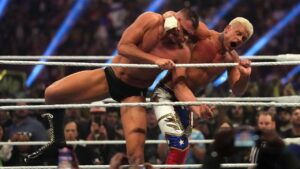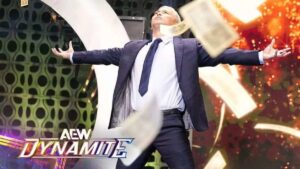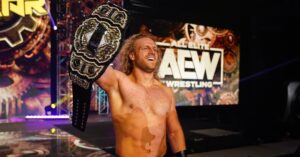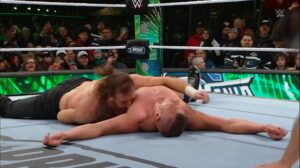The WWE has had multiple eras of greatness in it’s near 60-year history in sports entertainment. From its Golden Era in the 1960s with Bruno Sammartino, it’s Classic Era of the 1970s with Bob Backlund and “Superstar” Billy Graham, to the Rock N’ Wrestling Era of the 1980s, the WWE has transformed its image and vision with the times (although not always with the same success). But before the late 90s saw the rise of the Attitude Era in late 1997, and in the fall out of a steroid scandal and mass exodus of Rock N’ Wrestling main eventers to rival World Championship Wrestling (WCW), WWE’s New Generation – that ran from approximately 1993 to mid-1997 – is largely considered WWE’s low point. And for good reason. WCW was emerging as a more traditional wrestling powerhouse with Ted Turner pouring money into signing WWF’s most recognizable stars like Hulk Hogan, “Macho Man” Randy Savage, “Million Dollar Man” Ted DiBiase, and more, and ratings for WWF programming were on the brink of collapse. But in order to keep the machine going, the WWF had to rebuild from the bottom up.

They took former mid-card or tag team stars and pushed them in stronger singles competition, brought in castoffs from WCW, AWA and other promotions and found gold in other company’s trash, and tried to push more athleticism than at any point under Vince McMahon Jr.’s time in control. While it’s arguably best remembered from its seemingly never-ending run of terrible gimmicks, like Mantaur, The Goon, Saba Simba, and Phantasio, it was this forced inward analysis of the stars it had (and the unused talent from WCW and others it could afford) created a blueprint for the stars who ultimately helped WWE enter the Attitude Era, and with being being the world’s most-watched promotion by the decade (and century’s) end, would offer wrestlers who were more technical, more athletic, and less than powerlifting juggernauts, more of a chance of acceptance. Here’s a look at 20 Superstars of the WWF’s New Generation who helped revive interest in the WWE and leave an impression that for some remains dramatically underappreciated. Some had bigger pushes, some reached greater heights, but all of these people helped create new acceptable norms in the mainstream industry and pushed WWE back into the fight in a War it would ultimately emerge victorious from.
The Lost (New) Generation: WWF’s Most Maligned Era
Bret “Hitman” Hart

A member of one of the Rock N’ Wrestling Eras premier tag teams, The Hart Foundation, the technically gifted Bret Hart was the perfect choice to become the main face of the promotion. In many ways a throwback to former WWWF Champion Bob Backlund, McMahon went back to his father’s blueprint of having a strong technical wrestler who excelled equally in making himself look like a champion, but also make any opponent look worthy of a match against him. Bret’s first WWF World Heavyweight Championship win, against WCW/NWA legend Ric Flair in October of 1992, effectively launched the New Generation and Bret would become a 5x WWF World Champion over the next five years, and becoming one of the WWE’s biggest stars of the 1990s. Just as his victory over Flair launched the New Generation Era, the loss of his final WWF World title at Survivor Series in 1997 helped launch the Attitude Era.
Shawn Michaels

Much like Hart, Shawn Michaels was a tag team wrestler in the Rock N’ Wrestling Era, albeit during its final years. As a member of the popular Rockers tag team, Michaels was an emerging star with the younger demographic. Just as Bret Hart was ascending to the main event picture in 1992, the WWE needed fresh faces in their heel department as well. They got one of the greatest heel turns of all time that January, when Shawn Michaels turned on his longtime tag partner Marty Jannetty, becoming a top-level heel and singles star for the first time in his career. The same month that Hart won his first World title, Michaels won his first Intercontinental title, cementing a new hierarchy in the New Generations emerging main event and mid-card landscape. By 1996, Michaels had climbed the ladder – by hook and by crook – and won his own inaugural WWF World Championship, as the very real feud between Michaels and Hart began to captivate the world.
The Undertaker

Many have pointed to the various WCW rejects and castaways that WWF scooped up to fill space in the early 1990s, but none would have the impact on the WWE landscape like “Mean” Mark Callous when he joined the WWF in 1990. While he first debuted in the dying embers of the Rock N’ Wrestling Era and was quickly pushed to the World title scene (he won the WWF World Heavyweight Championship off Hulk Hogan in his first year), it wasn’t until the pasture cleared of it’s older stock that The Undertaker became a foundational imprint on the WWE Universe. He became more than just a haunting gimmick, with legendary wars with Bret Hart, Shawn Michaels, Sid Vicious, and more. He wouldn’t win his second WWF World title until early 1997, but by then The Undertaker was so comfortable in his gimmick that he became a natural leader to bring the WWF into the Attitude Era. And was one of the last gimmicks to survive in the new look WWF.
Yokozuna

Although times were changing in the WWF in the early 1990s, racial or cultural antagonists were still very much a stereotype that pro wrestling embraced (as did most popular culture like film). The arrival of Yokozuna in 1992 – oddly enough, in October, the same month that Bret won his first WWF World title and Michaels won his first Intercontinental – brought in the first great post-Rock N’ Wrestling heel. Managed by a rebooted Mr. Fuji, the pre-internet fans had no idea that Yoko was actually a member of the Samoan Anoi’a family, or that he was the nephew of former WWF Tag Team Champions The Wild Samoans and cousin of former WWF Superstar The Tonga Kid. In just under two years, he was a 2x WWF World Champion and one of the biggest threats to every face in the company, and although his stint was brief (he was gone by 1996 due to health reasons), he also helped elevate young stars like Owen Hart, who became his tag team partner.
Razor Ramon

Scott Hall had always been blessed with talent, but before arriving in the WWE, no one had properly been able to capture his charisma and psychology quite like the WWF. He worked in the AWA during it’s last few years when Verne Gagne finally decided to push younger talent and worked in WCW’s early days as The Diamond Studd, a character that began the initial oozing of the machismo. He left WCW in May of 1992 and joined WWF shortly after, repackaged as the Cuban Razor Ramon. An instant success as “The Bad Guy”, he became one of the top mid-card stars of the New Generation and a 4x Intercontinental Champion, bucking a trend that big men were better off as silent giants proving he could work and talk at the same time.
Diesel

Another of WCW’s lost projects, Kevin Nash had worn three different gimmicks in WCW between 1990 and 1993 before he decided to leave to join the WWF (he began as Master Blaster Steel in the Master Blasters tag team in 1990, became Oz in 1991, then Vinnie Vegas in 1993). But as WCW picked up more and more jettisoned WWF “names”, Nash saw that his glass ceiling was shrinking. He headed “up North” to WWF in 1993 and became Diesel, the tall, powerful and magnetically charismatic enforcer for Intercontinental Champion Shawn Michaels, and outgrew his sidekick role in a hurry. A combination of quick wit and a vicious streak that was rare for big men at the time, Diesel was pushed fast and furious, beating his “employer” Shawn Michaels to the WWF World Championship by two years.
Goldust

Dustin Rhodes – the man behind the gold paint for the better part of 30 years – finally departed the WWE earlier this month, but he was another WCW departure that the WWF took advantage of. While he was the son of WCW/NWA legend Dusty Rhodes, the changing management in WCW seemed to ignore “The Natural” Dustin Rhodes over time, and in 1995 he jumped to WWF where he was completely repackaged, ignoring all reference or acknowledgment of his famous bloodline. As the bizarre Goldust, he pushed envelopes that are still somewhat taboo now and became as off-putting as he was mesmerizing with his performance as the ambiguously sexual kink fetishist and movie buff. It was Goldust – and Dustin Rhodes’ – willingness to push the envelope and divulge himself in his character that helped the WWF to continue to step over the lines and enter the Attitude Era two years later.
Owen Hart

Owen Hart finally joined WWF in 1991, but it was just as the WWE decided to push his brother Bret into the mid-card as a singles wrestler. For a year he was stuck in tag teams – first The New Foundation with brother-in-law Jim “The Anvil” Neidhart and then High Energy with Koko B. Ware – before finally ending up as the masked wrestler Blue Blazer. But following bad press and departures, Owen Hart was finally allowed to be himself in 1993 and entered into a family feud with his brother that would run off and on for years. His match with Bret in the opening of WrestleMania X showcased just what Owen was capable of on his own, and in 1995 he joined former 2x WWF World Champion Yokozuna in the company’s most dominant tag team. A role player who could have classics with wrestlers from the low card to mid-card to the main event, Owen became the WWF’s ultimate utility player during the New Generation. Ironically, Owen was another WCW cast-off, who worked for the company in early 1991 before ending up in the WWF.
1-2-3 Kid

With the territorial system that had lorded over the wrestling world since the 1940s in a state of collapse and WWF looking beyond their competitors (who were nil except for WCW), WWF looked to the emerging US indies for new talent in the 1990s. Arguably the first indie darling to sign with the WWF, Sean Waltman was a rising star called The Lightning Kid when he signed with WWF in 1993. Repackaged as The Kid, he started out as enhancement, but in short fashion scored a huge upset victory over Razor Ramon to become a fan favorite and the WWF’s first true undersized underdog. His work on the indies is still emulated today and he would become a foot soldier in the Monday Night Wars with both WWE and WCW, but the emergence of the 1-2-3 Kid in the New Generation is one of the most underappreciated moments of the WWF’s early 1990s years.
The British Bulldog

Davey Boy Smith was another tag team specialist like Bret Hart and Shawn Michaels who was a big part of the Rock N’ Wrestling’s tag team division. But as injuries took their toll on his British Bulldogs partner Dynamite Kid, Smith turned to singles competition where he took his tag teams name as his own. Much like his real-life brother-in-law Bret Hart, he became an early success story, defeating Bret for the Intercontinental Championship in Wembley at SummerSlam 1992, but following the steroid scandal, he would also jump to WCW in 1993. He returned to WWF in 1994 and once again found his footing as a reliable soldier, most often tied up in family affairs, partnering with Owen Hart before joining a new Hart Foundation in early 1997.
Chris Candido & Sunny

The arrival of Sunny and Chris Candido – known in the WWF as Skip of the Bodydonnas – in 1995 was a breath of fresh air to the WWF Universe in the midst of the New Generation. As WWF tried to return to more traditional wrestling for its women, the arrival of Sunny brought back a sexiness not seen since NWA’s Precious. For good or for bad, it was Sunny’s influence on the teenage and early 20’s demographic that had a huge impact on the switch to more risque angles involving sexuality in pro wrestling. But Chris Candido was the opposite end of the spectrum. Much like Sean Waltman before him, Candido was an indie star who started off with the Monster Factory in New Jersey, before working through territories like Eastern Championship Wrestling (pre-extreme ECW) and Smokey Mountain Wrestling (SMW) before arriving in the WWF. His unique form of power and athleticism was an inspiration for more stars of today than anyone who wrestled in the 1990s. He would return to ECW after a short run as well as stints in WCW, NJPW and TNA/IMPACT Wrestling before tragically passing away in 2005.
https://www.youtube.com/watch?v=7jdyc0bw0_Y
Sensational Sherri

While it’s a fair argument that WWF missed the boat on not pushing Sherri Martel more as the elite level women’s wrestler she was (a former AWA and WWF Women’s Champion), without Sherri, it would have taken women much longer to be taken seriously as powerful managers for male wrestlers. While others had come before her (as a manager that is), like Miss Elizabeth, Sunshine and Precious, part of their character were that of being the submissive that was always due for a face turn to fight back their oppressor. But after Sherri took the reigns with Randy Savage and Shawn Michaels in the New Generation Era, women became more than just valets, but women who could be better strategists for their male companions (like Martel herself), to strong female leads like Marlena (Terri Runnels) with Goldust, Sunny with the Bodydonnas, Chyna with D-Generation X, and more. Major League Wrestling (MLW)‘s Salina De Le Renta owes more to Sherri Martel as a manager than she does Miss Elizabeth.
https://www.youtube.com/watch?v=qRwckPuU1Zc
Jeff Jarrett

Jeff Jarrett was the last of the territorial mid-card kings. Throughout the territorial days, being the king of the mid-card (or at least a high ranking sergeant) for a decade or three than being king of the main event for one year and bottom feeder for 20 years. Guys like Arn Anderson, Wahoo McDaniel, and Tully Blanchard excelled on this level. Jeff Jarrett was his father’s prodigy student, a hot young wrestler in Memphis in the 1980s, who became the heir apparent to Jerry Lawler in the early 1990s. He jumped to the WWF in the 1990s and became the standard bearer of the Intercontinental Championship for nearly two decades with 6 title reigns. Despite his World Championships with WCW, NWA and TNA/IMPACT, Jarrett always felt best served as the king of the mid-card instead of the king of the mountain. But his contributions to WWF’s New Generation success are a solid part of its backbone, and his multiple jumps during the War makes him the Little Fingers/Lord Baelish of the New Generation’s Game of Thrones.
Sycho Sid

Sid Vicious was a giant specimen being fast-tracked in WCW with a run with the Four Horsemen before jumping to the WWF in 1991. It was a short run and he was soon back in WCW, but it was his second stint from 1995 to 1997 that had a bigger impact. Now Psycho Sid in the WWF, he changed the game for big men as his feuds with the likes of The Undertaker, Bam Bam Bigelow, and Razor Ramon proved that two big men could feud and not have it a neanderthal clash of the Cro-Magnons fighting for spacial dominance. But Sid was limited with just other near seven footers – he also had clashes with Bret Hart, Steve Austin, and Owen Hart opened more doors for big men to work with more skilled workers.
Doink the Clown

Admittedly, we probably had you this far, even with Jeff Jarrett in the conversation. But Doink is a far more misunderstood and underrated character than many give Matt Borne credit for. Granted, when he debuted, he was an awkward clown character that was a failed experiment. But by the following year, Borne had found his inner Pennywise and Doink went from Cesar Romero‘s Joker to Jack Nicholson‘s. The clown had found his dark side, and his cruelty became an off-setting gimmick that has made the character endure to this day, despite original Doink Matt Borne’s passing. It was this kind of unsettling line crossings that lead to upping the game with Goldust.
Alundra Blayze

With All Japan‘s All Japan’s Women’s Pro Wrestling (AJW) leading the world with their performances, when WWE relaunched their women’s division in 1993, after years of inactivity, they turned to a former AWA Women’s Champion and WCW personality in Madusa Micelli, who spent three years with AJW from 1989 to 1991. Repackaged as Alundra Blayze, she became the face of the women’s division, in many ways the women’s division’s Bret Hart, and a 3x WWF Women’s Champion. Thanks to her, WWF brought in Japanese stars like Bull Nakano and Monster Ripper (although she was rebooted from vicious monster to country gal Bertha Faye).
Bull Nakano

One of Alundra Blayze’s suggestions was her greatest rival, Japan’s Bull Nakano. Wild, unpredictable, and plus sized, all of these made Nakano an inspiration. For the most part, prior to Nakano and Blayze’s epic multi-promotional rivalry, larger women were more comedic acts than wrestlers worth paying attention too. Even her peer Monster Ripper – a Canadian from Stu Hart’s Stampede Wrestling who was a threat in Japan – was repackaged as a bumbling backwoods grappler named Bertha Faye. But Nakano’s position as not only the greatest rival of Madusa’s career but a bridge that introduced many North Americans to joshi wrestling. And the potential that properly booked women’s wrestling could be, and that they didn’t need to look like models to succeed.
Billy Gunn

An underappreciated hand who helped carry the New Generations tag team division throughout the New Generation Era. After the collapse of the Rock N’ Wrestling Era and it’s tag teams of Bulldogs, Hart Foundation, Demolition, Rockers and more, Vince suddenly became timid when it came to caring about tag team wrestling. But the Smoking Gunns, a “brother” combo of cowboy brothers Bart and Billy Gunn came in quick and became huge fan favorites and 3x WWF World Tag Team Champions. It was during these New Generation years that Gunn excelled on his own moments while working on enhancing his tag partners strengths that made him one of the most decorated tag champs in WWE history, winning three with Smokin’ Gunns, six with Road Dogg in New Age Outlaws, and two with Chuck & Billy.
Hunter Hearst Helmsley

So many people let go by WCW who became bigger in WWF, although according to Eric Bischoff, a lot had to do with tighter finances in the early 90s as they rerouted funds for bigger impacts. But in 1995, another WCW hand jumped ship, when former New England indie wrestler Terra Ryzin’ and Lord Steven (William) Regal WCW tag partner Jean-Paul Leveque arrived in WWF as “The Blue Blood” Hunter Hearts Helsmley. While his choice of friends stunted his growth due to a certain call, he became another of the few “gimmicks” to push through the New Generation and become a huge part of the Attitude Era and ultimately, one of the WWE’s biggest influencers, as Triple H.
Steve Austin

WCW releasing “Mean” Mark Callous to the WWF to become The Undertaker is a huge “What If?” in WCW/WWE lore. But at least Callous was a marginal mid-card player in the tag division. Who knew. But when WCW released “Stunning” Steve Austin in 1995 – after being a part of the WCW Tag Champs Hollywood Blondes with Brian Pillman and 2x WCW United States and 2x WCW Television Champion in singles action – many were surprised. But it looked like WCW wanted to go with established WWF stars like Hogan and Savage over WCW prospects like Austin and Callous. After a stint in ECW in 1995, Austin joined WWF in January of 1996 as The Ringmaster, a protege of DiBiase. It would take a few years, but once he became “Stone Cold” he would become one of the industry’s biggest stars.
Mankind

The most unlikely hero of the New Generation, who became a focal point of the Attitude Era. The Tyrion Lannister of the WWF in the 1990s, but more gimp than Imp. Mick Foley had worked his way into WWF far too early in the 1980s, demented himself as Cactus Jack with WCW, ECW and Japan as a hardcore specialist before arriving in WWF nearly unrecognizable as Mankind in 1996. Granted it was the end of the New Generation, but thanks to advancements in people’s intrigue because of Undertaker to Papa Shango to Doink the Clown to Goldust, suddenly Mankind made sense. Once Mankind was revealed as Foley the storyline floodgate opened and he became the best utility player of the Attitude Era.






